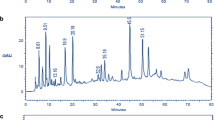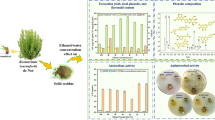Abstract
The traditionally derived syrup of Opuntia ficus-indica fruit is commonly used in homemade confectionery. Herein, the aqueous-acetone extract prepared from the Tunisian O. ficus-indica syrup was investigated. The qualitatively and quantitatively polyphenolic content was analysed using reversed-phase high-performance liquid chromatography–diode array detection (RP-HPLC–DAD) coupled to electrospray ionisation–mass spectrometry (ESI–MS). The extract contained 19.95 ± 2.01 mg phenolics per gram of fresh starting material with isorhamnetin 3-O-robinobioside as the major compound (22.76%). The syrup extract showed strong antioxidant potentials as assessed by both ABTS and DPPH functional methods. It exhibited effective antimicrobial activity, particularly against Staphylococcus aureus and Staphylococcus epidermidis with a minimal bactericide concentration (MBC) of 1.3 mg phenolics/ml. Furthermore, at final concentrations in the range of 41.38–186.25 μg polyphenols/ml, the extract decreased human SH-SY5Y neuroblastoma and 3T3 fibroblast in vitro cell viability in a dose- and time-dependent manner compared to non-treated control cells. The observed effects were significantly (P < 0.05) high against cancer lines. Extract concentrations higher than 106.43 μg/ml reduced cancer cells viability to 50–60% 1–3 h post-treatment. Further in vivo insight studies should emphasise and validate the herein obtained results.


Similar content being viewed by others
References
Agozzino P, Avellone G, Caraulo L, Ferrugia M, Flizzola F (2005) Volatile profile of Sicilian prickly pear (Opuntia ficus-indica) by SPME-GC/MS analysis. Int J Food Sci 17:341–348
Aleksandra S, Agnieszka T, Edward S (2011) Determination of antioxidant capacity of unprocessed and processed food products by spectrophotometric methods. Food Anal Methods. doi:10.1007/s12161-011-9314-1
Barrajon E, Fernandez S, Saura D, Guillen E, Fernandez A, Segura A, Vicente M (2010) Cistaceae aqueous extracts containing ellagitannins show antioxidant and antimicrobial capacity, and cytotoxic activity against human cancer cells. Food Chem Toxicol 48:2273–2282
Baydar NG, Özkan G, Sagdiç O (2004) Total phenolic contents and antibacterial activities of grapes (Vitis vinifera L.) extracts. Food Control 15:335–339
Butera D, Tesoriere L, Digaudio F, Bongiorno A, Allegra M, Pintaudi AM, Kohen R, Livrea M (2002) Antioxidant activities of sicilian prickly pear (Opuntia ficus indica) fruit extracts and reducing properties of its betalains:betanin and indicaxanthin. J Agric Food Chem 50:6895–6901
De Leo M, Bruzual M, Pawlowska AM, Cioni PL, Braca A (2010) Profiling the chemical content of Opuntia ficus-indica flowers by HPLC–PDA-ESI-MS and GC/EIMS analyses. Phytochem Lett 3:48–52
Denizot F, Lang R (1986) Rapid colorimetric assay for cell growth and survival. Modifications to the tetrazolium dye procedure giving improved sensitivity and reliability. J Immunol Meth 89:271–277
Dhaouadi K, Raboudi F, Estevan C, Barrajon E, Vilanova E, Hamdaoui M, Fattouch S (2011) Cell viability effects and antioxidant and antimicrobial activities of Tunisian date syrup (Rub El Tamer) polyphenolic extracts. J Agric Food Chem 59:402–406
Dok-Go H, Lee KH, Kim HJ, Lee EH, Lee J, Song YS, Lee YH, Jin C, Lee YS, Cho J (2003) Neuroprotective effects of antioxidative flavonoids, quercetin, (+)-dihydroquercetin and quercetin3-methyl ether, isolated from Opuntia ficus-indica var. saboten. Progress Brain Res 965:130–136
FAO (2004) Date palm production. www.fao.org/docrep/t0681E/t0681E00.htm
Fattouch S, Caboni P, Coroneo V, Tuberoso CIG, Angioni A, Dessi S, Marzouki N, Cabras P (2007) Antimicrobial activity of Tunisian quince (Cydonia oblonga Miller) pulp and peel polyphenolic extracts. J Agric Food Chem 55:963–969
Friedman M, Mackey BE, Kim HJ, Lee IS, Lee KR, Lee SU, Kozukue N (2007) Structure-activity relationships of tea compounds against human cancer cells. J Agric Food Chem 55:243–253
Galati EM, Mondello MR, Giuffrida D, Dugo G, Miceli N, Pergolizzi S, Taviano MF (2003) Chemical characterization and biological effects of Sicilian Opuntia ficus indica (L.) Mill. fruit juice: antioxidant and antiulcerogenic activity. J Agric Food Chem 51:4903–4908
Galati EM, Mondello MR, Lauriano ER, Taviano MF, Galluzzo M, Miceli N (2005) Opuntia Ficus indica (L.) Mill. fruit juice protects liver from carbon tetrachloride-induced injury. Phytother Res 19:796–800
Gurrieri S, Miceli L, Lanza CM, Tomaselli F, Bonomo RP, Rizzarelli E (2000) Chemical characterization of Sicilian prickly pear (Opuntia ficus indica) and perspectives for the storage of its juice. J Agric Food Chem 48:5424–5431
Hfaiedh N, Allagui MS, Hfaiedh M, El Feki A, Zourgui L, Croute F (2008) Protective effect of cactus (Opuntia ficus indica) cladode extract upon nickel-induced toxicity in rats. Food Chem Toxicol 46:3759–3763
Ikigai H, Nakae T, Hara Y, Shimamura T (1993) Bactericidal catechins damage the lipid bilayer. Biochim Biophys Acta 1147:132–136
Ivanova V, Dörnyei Á, Stefova M, Stafilov T, Vojnoski B, Kilár F, Márk L (2011) Rapid MALDI-TOF-MS detection of anthocyanins in wine and grape using different matrices. Food Anal Meth 4:108–115
Koneman EW (1995) Atlas of Diagnostic Microbiology; Delfino, A, Ed. Italy, pp 549–560
Kulkarni AP, Mahal HS, Kapoor S, Aradhya SM (2007) In vitro studies on the binding, antioxidant, and cytotoxic action of punicalagin. J Agric Food Chem 55:1491–1500
Kuti JO (2004) Antioxidant compounds from four Opuntia cactus pear fruit varieties. Food Chem 85:527–533
Lantto TA, Colucci M, Zavadova V, Hiltunen R, Raasmaja A (2009) Cytotoxicity of curcumin, resveratrol and plant extracts from basil, juniper, laurel and parsley in SH-SY5Y and CV1-P cells. Food Chem 117:405–411
Menendez JA, Vazquez A, Colomer R, Brunet J, Carrasco A, Garcia, Fernandez A, Segura A (2007) Olive oil’s bitter principle reverses acquired autoresistance to trastuzumab (Herceptin) in HER2- overexpressing breast cancer cells. BMC Cancer 7:80–91
Najjaa H, Zerria K, Fattouch S, Ammar E, Neffati M (2011) Antioxidant and antimicrobial activities of Allium roseum L. “Lazoul,” a wild edible endemic species in North Africa. Int J Food Prop 14:371–380
Ncibi S, Ben Othman M, Akacha A, Krifi M, Zourgui L (2008) Opuntia ficus indica extract protects against chlorpyrifos-induced damage on mice liver. Food Chem Toxicol 46:797–802
Piga A, Del Caro A, Pinna I, Agabbio M (2003) Changes in ascorbic acid, polyphenol content and antioxidant activity in minimally processed cactus pear fruits. LWT-Food Sci Technol 36:257–262
Rodriguez Vaquero MJ, Alberto MR, Manca de Nadra MC (2007) Antibacterial effect of phenolic compounds from different wines. Food Chem 18:93–101
Sanchez-Alonso I, Jimenez-Escrig A, Saura-Calixto F, Borderias AJ (2007) Effect of grape antioxidant dietary fibre on the prevention of lipid oxidation in minced fish: evaluation by different methodologies. Food Chem 101:372–378
Sogorb MA, Ganzalez GI, Pamies D, Vilanova E (2010) An alternative in vitro method for detecting neuropathic compounds based on acetylcholinesterase inhibition and on inhibition and aging of neuropathy target esterase (NTE). Toxicol in Vitro 24:942–952
Sreekanth D, Arunasree MK, Roy KR, Reddy TC, Reddy GV, Reddanna P (2007) Betanin a betacyanin pigment purified from fruits of Opuntia ficus-indica induces apoptosis in human chronic myeloid leukemia Cell line-K562. Phytomedicine 14:739–746
Taguri T, Tanaka T, Kouno I (2004) Antimicrobial activity of 10 different plant polyphenols against bacteria causing food-borne disease. Biol Pharm Bull 27:1965–1969
Tao Y, Hideaki Y, Toshiro N, Yumi K, Hironori U, Kazuo R (2010) Selective cytotoxicity of glycyrrhetinic acid against tumorigenic r/m HM-SFME-1 cells: potential involvement of H-Ras downregulation. Toxicol Lett 192:425–430
Tesoriere L, Butera D, Pintaudi M, Allegra M, Livrea MA (2004) Supplementation with cactus pear (Opuntia ficus-indica)fruit decreases oxidative stress in healthy humans: a comparative study with Vit. C. Am J Clin Nut 80:391–395
Tuberoso CIG, Kowalczyk A, Sarritzu E, Cabras P (2007) Determination of antioxidant compounds and antioxidant activity in commercial oilseeds for food use. Food Chem 103:494–501
Yang SK, Yoneda F, Oide H, Sakae M (1998) Isorhamnetin 3-O-robinobioside, its manufacture, and testosterone 5a-reductase inhibitors and therapeutics containing the flavonoid derivative. Japanese Kokai Tokkyo Koho 7 pp
Zou DM, Brewer M, Garcia F, Feugang JM, Wang J, Zang R, Liu H, Zou C (2005) Cactus pear: a natural product in cancer chemoprevention. Nutrition 4:25–36
Acknowledgements
The authors would like to thank Prof. Eugenio Vilanova, Miguel Angel Sogorb and Vicent Micole from the Instituto Bioingeniería (Universidad Miguel Hernandez, Elche, Alicante, Spain) for their supportive advices. We acknowledge the financial support from the Ministry of Higher Education and Scientific Research (Tunisia), and the Agencia Espanola De Cooperacion Internacional (Spain, Spanish–Tunisian project A/017920/08).
Author information
Authors and Affiliations
Corresponding author
Rights and permissions
About this article
Cite this article
Dhaouadi, K., Raboudi, F., Funez-Gomez, L. et al. Polyphenolic Extract of Barbary-Fig (Opuntia ficus-indica) Syrup: RP–HPLC–ESI–MS Analysis and Determination of Antioxidant, Antimicrobial and Cancer-Cells Cytotoxic Potentials. Food Anal. Methods 6, 45–53 (2013). https://doi.org/10.1007/s12161-012-9410-x
Received:
Accepted:
Published:
Issue Date:
DOI: https://doi.org/10.1007/s12161-012-9410-x




